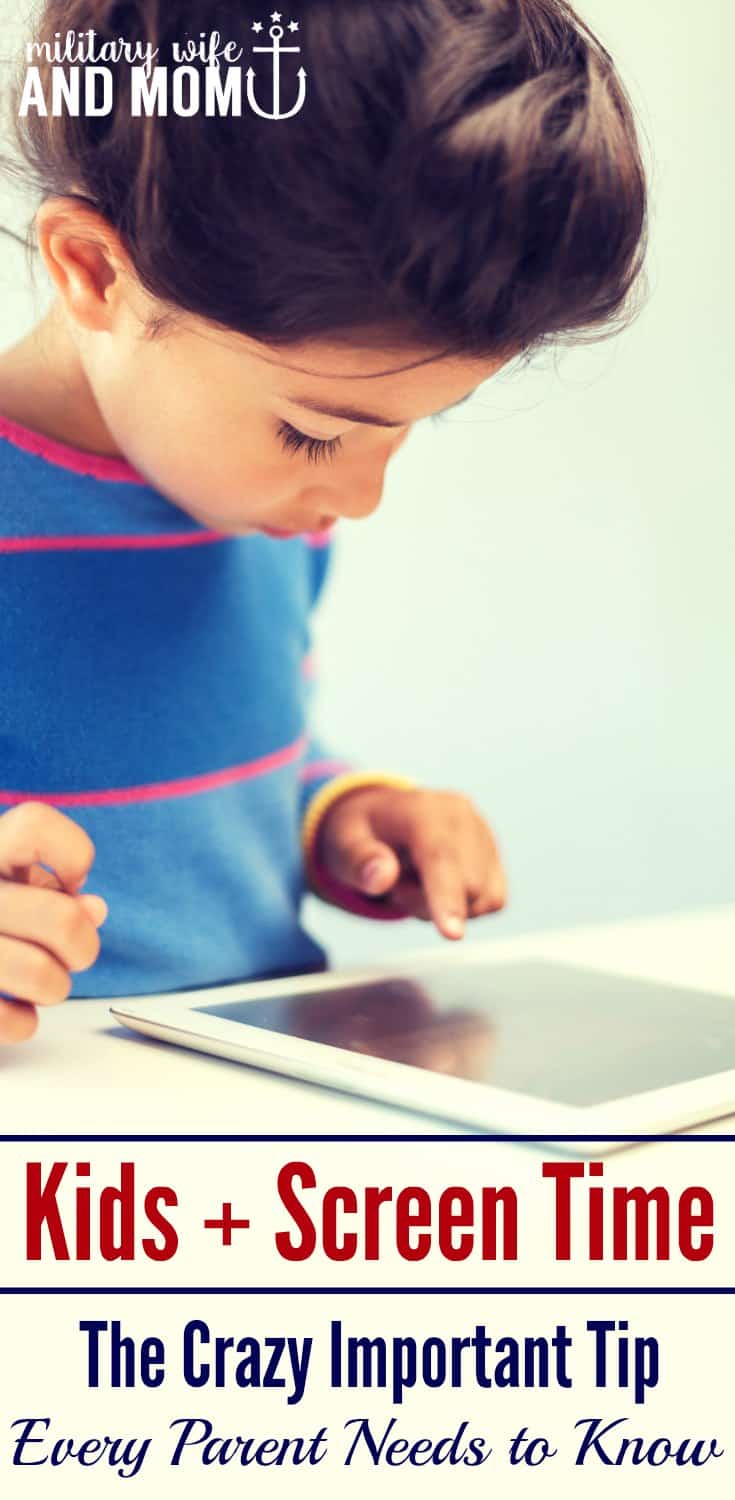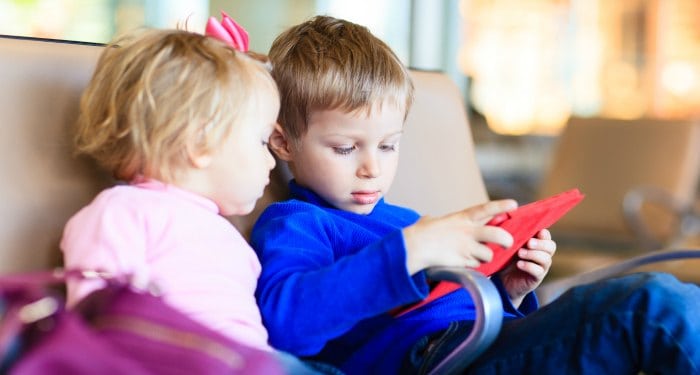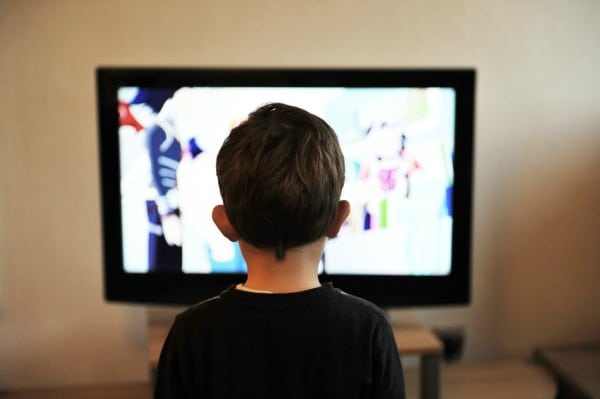Inside this post: The most important screen-time recommendation for kids that every parent should know. Science-based tips for kids and screen-time.

If I didn’t know this science-based tip about kids and screen-time, my son’s behavior during our bedtime routine would’ve infuriated me.
And it probably would’ve resulted in me wanting to launch him straight into bed, snap the lights off and seal his bedroom door shut.
Wanting is the keyword because I wouldn’t Hulk launch my kid into bed, but surely I would’ve gone angry mom.
It all started with a movie.
The kids and I returned home from running errands and my son immediately asked to watch the movie Curious George. I thought about it for a hot second and responded with a head nod.
Not because I was exhausted from the day. Not because I didn’t want to play with the kids. And definitely not because I wanted to go clean the tile grout in the bathroom.
The truth is that we are not a screen-free home. Both the kids are allowed to watch TV in moderation in the morning and late afternoon. I was totally fine with it.

post contains affiliate links, see my disclosure here.
This is where it gets tricky.
During the movie, there are several parts where George is acting notoriously silly. He’s running around and hiding from the Man in the Yellow Hat, who keeps trying to catch George.
From a parent’s point of view, this is about as innocent as screen-time can get.
Meanwhile, my son is laughing hysterically. Like belly laughing non-stop. This little chasing game between George and the Man in the Yellow Hat enacted all of his senses. He knows this is the part of the movie with high action and his brain is telling him to “pay attention.”
Here’s why this matters.
Anytime kids are exposed to screen-time, they are exposed to some sort of conflict within the television show, electronic game or movie. And during times of “conflict,” your child’s senses are heightened.
Think: increased heart rate, blood pressure, or raised hair on the skin.
This situation of heightened senses is the exact moment your child’s brain is told to “pay attention.” The child doesn’t necessarily understand the conflict occurring before them, but they are bookmarking it for later.

And bookmarking it for later usually involves the child playing out the conflict in real life through role-play or schemas.
If you haven’t heard of schemas, they are patterns of behavior that allow kids to develop ideas and thoughts about the world through play. In the context of screen-time, schematic play allows kids to make sense of the conflict that happened during a movie, TV show or electronic game.
This is the most important part.
Later that night, our son became wildly rambunctious, wanting to play a chasing game. Normally, he follow his printable routine cards and we are good to go.
On this night, however, he refused to put on his pajamas, and instead, insisted on running laps around the house naked.
But according to science, this post screen-time behavior is expected.
Children who observe aggressive or high conflict behavior through media are very likely to perform the same behavior immediately afterward.
“Long-term increases in children’s aggressive behavior are now generally agreed to be a consequence of the child’s learning scripts for aggressive behavior, cognitions supporting aggression, and aggression-promoting emotions through the observation of others behaving violently.” (source)
Now you may scoff and say, kids shows aren’t all that violent or aggressive.
C’mon, right?
But in all seriousness, seeing Sponge Bob Square Pants bonk someone on the head or watching a high action scene in the Minions movie, appears aggressive to a small child.

After observing simple conflict in a very innocent movie, my son was acting out these behaviors through schematic play. He was trying to make sense of how these limit-pushing chasing games work in real life, and how they affect relationships.
Knowing this ahead of time dramatically changed the way I responded to my son’s behavior.
Gently, but confidently, I wrangled him and said, “Oh I see. You want to be George from the movie. And you want me to be the Man in the Yellow Hat.”
And right there he smiled, nodded and affirmed that I understood exactly what he was doing.
I continued, “Right now it’s bedtime, and it looks like you need help getting your pajamas on because you’re really excited. You want to pretend you’re George, and tomorrow when we play together I will pretend with you. Right now it’s bedtime.”
As I continued to help him get dressed, I talked to him about the movie. The silly games. The angry man. Any type of positive or negative conflict I could remember. He calmed enough to follow his printable routine cards and the following day, we role-played the movie.
This simple shift was massive for gaining his cooperation and moving forward.
Moving forward: 3 simple steps.
1. If you start to see misbehavior after screen-time, it may be your child acting out schemas to understand behaviors witnessed during the movie or game. It’s great to be aware and can bring your frustration way down knowing this!
2. When choosing the TV shows, movies and electronic games your child plays, plan for the conflict they may need to work out afterward. If you aren’t too keen acting out a dinosaur fight with your kids, feel free to help them choose a lighter movie.
3. Remember that–above all else–you are your child’s parent, their safe person. There’s a high chance the misbehavior and acting out through schemas will occur at home with you. And that’s a good thing. You’ll be right there to help your child make sense of it, act it out and move forward.

References:
- Bushman, B. J., Chandler, J., & Huesmann, L. R. (2010). Do violent media numb our consciences?. In W. Koops, D. Brugman, T. J. Ferguson, A. F. Sanders, W. Koops, D. Brugman, … A. F. Sanders (Eds.) , The development and structure of conscience(pp. 237-251). New York, NY, US: Psychology Press.
- Bushman, B. J. & Huesmann, L. R. (2006). Short-term and long-term effects of violent media on aggression in children and adults. Archives of Pediatric Adolescent Medicine, 160 (4) 348-352..
Print this free toddler listening checklist.
This post comes with a free printable checklist to help with toddler listening. I always have the hardest time remembering these phrases. This printable simplifies it!
Here is a sneak preview…
Download Your Free Printable
- Download the checklist. You’ll get the printable, plus join 37,000+ parents who receive my weekly parenting tips and ideas!
- Print. Any paper will do the trick, but card stock
would be ideal.
- Place it on your refrigerator. Check things off as you go and don’t forget a thing!














This is totally true. I still remember that, as a kid, after watching a movie in which there was a character that particularly impressed me, I “became” that person in my head and the movie and the story wasn’t over when the film was. I was “in it” the whole day and sometimes even the next morning. I definitely tried to emulate what or who I admired from the story – remember, children are wired to imitate. So, good call on reminding me of that – I had forgotten! Thanks Lauren!
I was looking for a printable of The Most Overlooked Reason Why Kids Won’t Listen.
I don’t see it here.